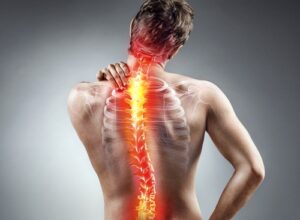The spine is also known as the vertebral column or the backbone And plays a critical role in the human anatomy. As the structural axis of the body, it provides stability, supports the upper body weight, and houses the spinal cord. However various factors such as aging, lifestyle choices, and injuries can compromise the health of the spine, leading to an array of problems. This article aims to delve into the heart of spine problems, exploring their roots, the accompanying symptoms, and the paths to effective management.
Contents
What Are Common Spine Problems?
 Navigating the intricate world of spine health necessitates a profound understanding of the prevalent spine problems that plague individuals globally. As the backbone of our body, the spine’s well-being is intricately linked to our overall health, making it imperative to unravel the complexities of common spinal issues and seek avenues for prevention.
Navigating the intricate world of spine health necessitates a profound understanding of the prevalent spine problems that plague individuals globally. As the backbone of our body, the spine’s well-being is intricately linked to our overall health, making it imperative to unravel the complexities of common spinal issues and seek avenues for prevention.
Herniated Disc
A herniated disc, also known as a slipped or ruptured disc, occurs when the soft inner portion of a disc leaks out through a crack in the outer ring. This can irritate nearby nerves and result in pain, numbness, or weakness in the arms or legs. It predominantly occurs in the lumbar region but can also affect the cervical and thoracic areas.
Spinal Stenosis
Spinal stenosis is a condition characterized by a narrowing of the spaces within your spine, which can put pressure on the nerves that travel through the spine. It is most often caused by wear-and-tear changes in the spine related to osteoarthritis. Symptoms can include pain, numbness, muscle weakness, and impaired bladder or bowel function.
Scoliosis
Scoliosis is a spinal deformity where a person’s spine curves to the side. The curve is usually “S”- or “C”-shaped over three dimensions. While it can occur at any age, it often occurs during puberty. It can lead to other issues such as chronic pain, respiratory deficiencies, and decreased exercise capacity.
Osteoporosis
This is a bone disease that affects the spine, characterized by a decrease in bone density and an increased risk of fractures. When it affects the spine, it can lead to compression fractures which can be very painful and can result in a stooped posture.
Degenerative Disc Disease
As we age, the discs between the vertebrae in the spine can break down, leading to degenerative disc disease. This condition can result in pain, usually lower back pain or neck pain, and reduced flexibility in the spine, making movement more challenging.
Spondylolisthesis
This condition occurs when one bone in your back (vertebra) slips forward over the bone below it. It can cause the spinal cord or nerve roots to become pinched, creating back pain and numbness or weakness in one or both legs. It primarily affects the lower back.
Ankylosing Spondylitis
An inflammatory disease that can cause some of the vertebrae in your spine to fuse together. This fusion makes the spine less flexible and can result in a hunched-forward posture. Symptoms can include chronic pain and stiffness, often starting in the lower back and hips.
Spinal Fractures
Caused by trauma, osteoporosis, or cancer, spinal fractures can result in a significant amount of back pain. Depending on the severity of the fracture, it might require surgical intervention to stabilize the spine.
Spinal Cord Injuries
Injuries to the spinal cord can be caused by accidents or falls and can result in symptoms ranging from pain to paralysis, depending on the severity of the injury and the site of impact on the spine.
Muscle Strains and Sprains
These are common injuries affecting the muscles and ligaments in the back. They can occur due to heavy lifting, sudden twisting, or a fall. Symptoms typically include localized pain, stiffness, and sometimes muscle spasms.
Understanding these common spine problems is a pivotal step in seeking appropriate treatment and managing symptoms effectively.
What Are The Causes Of Spine Problems?
 The causes of spine problems are manifold and often intertwine with various lifestyle, environmental, and genetic factors. Here are some of the primary causes:
The causes of spine problems are manifold and often intertwine with various lifestyle, environmental, and genetic factors. Here are some of the primary causes:
- Aging
As individuals age, the spine naturally wears and tears, which can lead to conditions like osteoarthritis, degenerative disc disease, and spinal stenosis.
- Poor Posture
Constant slouching or hunching, especially during work or while using handheld devices, can put extra strain on the spine, leading to long-term issues.
- Sedentary Lifestyle
A lack of regular physical activity can weaken the muscles that support the spine, making it more prone to injuries and problems.
- Injuries and Accidents
Trauma from falls, accidents, and sports injuries can cause immediate spine problems, including fractures, sprains, and spinal cord injuries.
- Obesity
Excessive body weight puts additional pressure on the spine, which can hasten the degeneration of spinal structures.
- Occupational Hazards
Jobs that involve heavy lifting, twisting, or bending can put workers at a higher risk of developing spine problems.
- Inflammatory and Infectious Diseases
Conditions like rheumatoid arthritis and infections can affect the spine, causing pain and other symptoms.
- Nutritional Deficiencies
Lack of essential nutrients, particularly calcium and vitamin D, can affect bone health, making the spine more susceptible to fractures and other problems.
How Can I Improve My Weak Spine?
 Improving a weak spine entails adopting a holistic approach that encompasses lifestyle modifications, physical therapy, and medical interventions when necessary. Here’s a guide to bolstering a weak spine:
Improving a weak spine entails adopting a holistic approach that encompasses lifestyle modifications, physical therapy, and medical interventions when necessary. Here’s a guide to bolstering a weak spine:
Physical Therapy
Engaging in a targeted physical therapy program can help strengthen the muscles that support the spine.
- Strengthening Exercises: Focus on exercises that build strength in your core and back muscles.
- Stretching: Incorporate regular stretching to enhance flexibility and prevent stiffness.
- Postural Training: Learn and practice proper posture to reduce strain on your spine.
Regular Exercise
Regular physical activity is paramount in maintaining a healthy spine.
- Aerobic Exercises: Engage in activities like walking, swimming, or cycling to enhance overall fitness.
- Yoga and Pilates: These disciplines can be particularly beneficial in strengthening the spine and improving posture.
Lifestyle Modifications
Adapt your daily life and workspace to be spine-friendly.
- Ergonomic Furniture: Use chairs and tables that support the natural curve of your spine.
- Proper Lifting Techniques: Learn to lift heavy objects using your legs, not your back, to prevent strain and injury.
- Maintaining a Healthy Weight: Excessive body weight can put additional pressure on the spine. Maintain a healthy weight to avoid unnecessary strain.
Stress Management
Chronic stress can lead to muscle tension and pain in the back. Implement stress management techniques such as meditation and deep breathing exercises.
Adequate Sleep
Ensure you get enough rest, and use a mattress and pillow that provide proper support to your spine.
Quit Smoking
Smoking can hinder blood flow to the discs of the spine, causing them to degenerate faster.
Implementing these strategies can significantly improve the health and strength of your spine, promoting better posture and reducing the risk of spine-related problems in the future.
What Foods Are Good For The Spine?
Eating the right kind of foods is not just beneficial for your overall health but can specifically fortify your spine, ensuring its long-term wellness. The cornerstone of a spine-friendly diet is the inclusion of calcium-rich foods which are paramount in bolstering bone density. Dairy products like milk, cheese, and yogurt, along with green leafy vegetables such as kale and spinach, are excellent sources.
Alongside, it is indispensable to enrich your diet with Vitamin D, a critical nutrient that facilitates calcium absorption in the body. Fatty fishes like salmon and tuna, egg yolks, and fortified cereals are potent sources. Further, staying hydrated is vital, as water forms a significant component of the intervertebral discs that cushion the vertebrae. Therefore, incorporating a balanced diet replete with essential nutrients can foster a robust and healthy spine.
Conclusion
In conclusion, spine health stands as a pivotal yet often overlooked component of our overall well-being. As we navigate through the intricacies of spinal issues and their prevention, it becomes evident that a proactive approach encompassing a nutritious diet, regular exercise, and ergonomic lifestyle choices can foster a resilient spine.
Let us embrace these spine-friendly habits, transforming our lives into a haven of health and comfort, one vertebra at a time. If you’re experiencing Back pain, physical therapy for back pain at PhysioMantra can help: Book an online physical therapy session.



